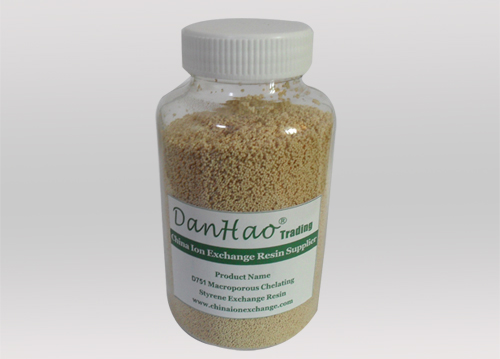D751 Macroporous Iminodiacetic Chelating Resin
Equivalence:Lewatit TP207,Diaion CR10/11,Dowex XZ95843,Purolite S930,ResinTech SIR300,Amberlite IRC748/718,IONAC SR5,Tulsion CH-90.
D751 is a macroporous polystyrene based chelating resin, with iminodiacetic groups designed for the removal of cations of heavy metals from industrial effluents. These cations may be separated from high concentrations of univalent cations (typically sodium) and also from common divalent cations (such as calcium). Removal can be achieved both from weakly acidic and weakly basic solutions depending on the metals to be removed.
D751 finds use in processes for extraction and recovery of metals from ores, galvanic plating solutions, pickling baths, and effluents even in the presence of alkaline earth metals (calcium and magnesium). Further important uses include the refining of the salt solutions of transition and precious metals and for the cleaning and purification of various organic or inorganic chemical products by removal of heavy metals contamination (usually from aqueous solution).
APPLICATION:D751 is particularly suitable for the removal of heavy metals (as weakly acidic chelated complexes) which are held according to the following order of selectivity.Cu>>Ni>Zn³Co³Cd>Fe(ll)>Mn>Ca
The macroporous resin structure ensures excellent diffusion of ions thus affording efficient exhaustion and regeneration.
Recovery of heavy metals from effluents from the plating industry is achieved by concentration and is particularly useful where full demineralisation and recycling of the rinse water is not practised. The simplest case is where only one heavy metal is present, when volumes of rinse water are low, waste water fees may be low, and raw water has a low salt content.
D751 can be used to reduce residual toxic heavy metals to below the maximum admissible concentration levels which are often far below those obtainable after precipitation reactions. It may also be used to remove similar residuals from demineralised rinse water circuits.
D751 is also used to separate and concentrate heavy metals in hydrometallurgical processes (ore dressing and scrap recovery). It is particularly suitable where metals are present in low concentrations. Separation techniques may be carried out according to the order of selectivity given above. However changes in the sequence occur with change in pH and in the presence of certain anions (including higher concentrations of chloride and sulphate). The sequence given above is applicable for neutral and weakly acidic solutions.
PROPERTIES | |
| Matrix | Macroporous Cross linked polystyrene |
| Functional Group | Iminodiacetic |
| Ionic Form | Na+ Sodium |
| Physical Form | Opaque Beige Beads |
| Particle size (mm) | 0.315-1.25 |
| Moisture content % | 55-65 |
| Total Exchange Capacity (Min) | 30g of Cu2+/L resin |
| Bulk density or shipping weight gms/ltr | 710-780 |
| Operating pH range | 2-6 for H+/6-11 for Na+ |
| Solubility in common solvents | Insoluble |
| Operating Temperature℃ (max) | 70 |
| Volume change% (max):H+ to Na+ | 20 |
| SUGGESTED OPERATING CONDITIONS | ||
| Bed Depth | Meter | 1.0-3.0 |
| Regenerant Concentration | % | Mineral Acids |
| Regenerant Flow Rate | BV/Hour | 3-4 |
| Regenerant Contact Time | Minutes | 30-60 |
| Regeneration Level 100% | Kgs/m3 of resins | 140-200 HCL |
| Rinse Flow Rate | BV/Hour | 2-4 |
| Rinse Time | Minutes | 20-40 |
| Running Flow Rate | BV/Hour | 8-16 |
PACKING:
1Cubic Meter Bulk Bag
25Liter Bag
25kg Bag
50kg Plastic Barrel


